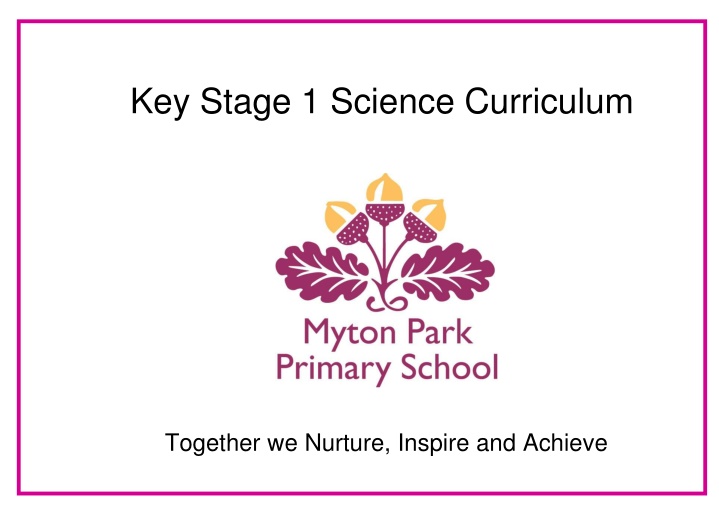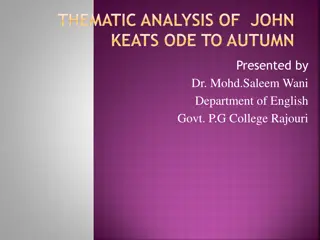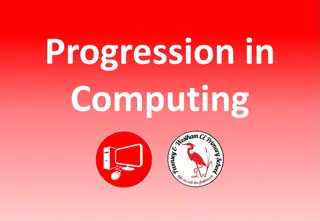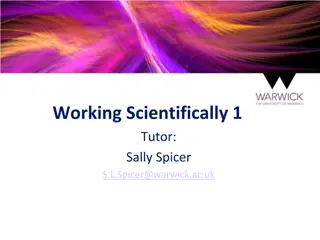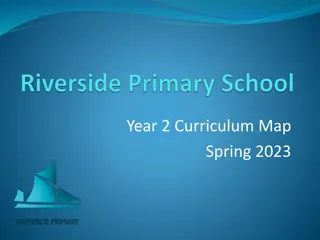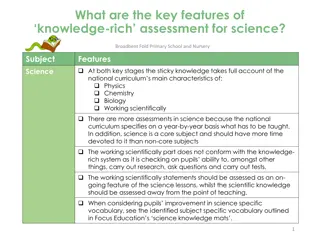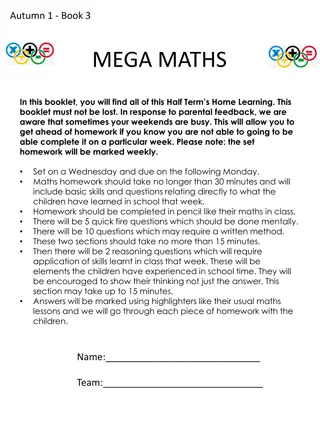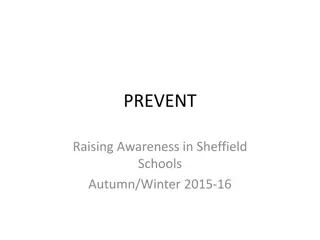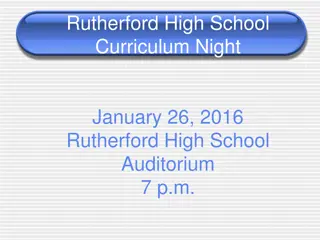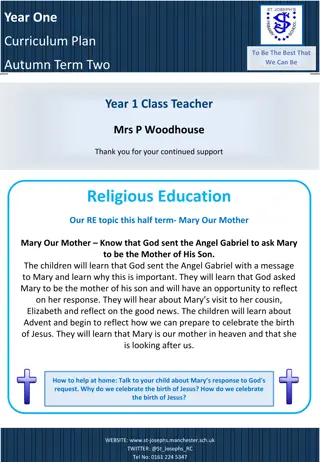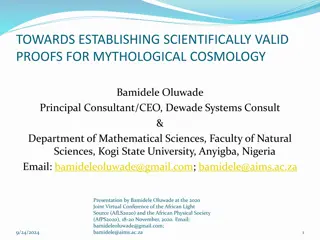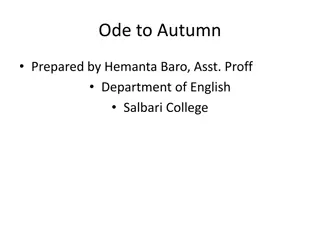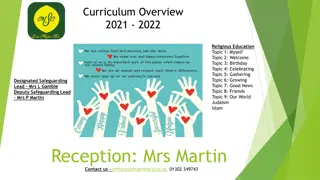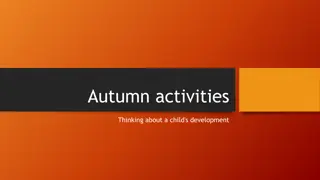Key Stage 1 Science Curriculum - Working Scientifically and Autumn Term Lessons
Key Stage 1 Science Curriculum focuses on developing scientific inquiry skills through systematic observations, measurements, data recording, and analysis. The curriculum progression includes asking questions, planning and conducting experiments, and drawing conclusions. The Autumn Term lessons explore plant identification, structures, materials, and categorization, nurturing children's curiosity about the natural world.
Download Presentation

Please find below an Image/Link to download the presentation.
The content on the website is provided AS IS for your information and personal use only. It may not be sold, licensed, or shared on other websites without obtaining consent from the author.If you encounter any issues during the download, it is possible that the publisher has removed the file from their server.
You are allowed to download the files provided on this website for personal or commercial use, subject to the condition that they are used lawfully. All files are the property of their respective owners.
The content on the website is provided AS IS for your information and personal use only. It may not be sold, licensed, or shared on other websites without obtaining consent from the author.
E N D
Presentation Transcript
Key Stage 1 Science Curriculum Together we Nurture, Inspire and Achieve
Science: Working Scientifically This table shows the progression across the Milestones and the expectations to be incorporated into planning at Milestone 1 Milestone 2 Milestone 3 Milestone 1 Ask relevant questions. Set up simple, practical enquiries and comparative and fair tests. Making systematic and careful observations and where appropriate make accurate measurements using standard units, using a range of equipment, e.g. thermometers and data loggers. Gather, record, classify and present data in a variety of ways to help in answering questions. Record findings using simple scientific language, drawings, labelled diagrams, bar charts and tables. Report on findings from enquiries, including oral and written explanations, displays or presentations of results and conclusions. Use results to draw simple conclusions and suggest improvements, new questions and predictions for setting up further tests. Identify differences, similarities or changes related to simple, scientific ideas and processes. Use straightforward, scientific evidence to answer questions or to support their findings. Plan enquiries, including recognising and controlling variables where necessary. Take measurements, using a range of scientific equipment, with increasing accuracy and precision, take repeat readings where appropriate. Record data and results of increasing complexity using scientific diagrams and labels, classification keys, tables, bar and line graphs, and models. Report findings from enquiries, including oral and written explanations of results, explanations involving causal relationships, and conclusions. Present findings in written form, displays and other presentations. Use test results to make predictions to set up further comparative and fair tests. Use simple models to describe scientific ideas, identifying scientific evidence that has been used to support or refute ideas or arguments. Ask simple questions and recognising they can be answered in different ways. Observe closely, using simple equipment. Perform simple tests. Identify and classify. Use observations and ideas to suggest answers to questions. Gather and record data to help in answering questions.
Science: Autumn Term This table shows the knowledge that will be taught in each lesson Year 2 Year 1 Milestone What are the names of common wild plants? What are the names of some common garden plants? What are the names of common trees? Which trees are evergreen and which are deciduous? (name) What are the similarities and differences between deciduous and evergreen trees? Think of some ways to categorise plants. Could you suggest a garden design for someone who likes privacy and bright autumn colours? Lesson 1: Biology Identify and name a variety of common plants, including garden plants, wild plants and trees and those classified as deciduous and evergreen. What are the names the parts of flowering plants? What is the structure (names) of each part of a flowering plant? Taking a selection of (real) different flowering plants, what are the structural features? (apply) Are roots always at the bottom of plants (generalise)? Why do you think that is? (explain concept) Lesson 2: Biology Identify and describe the basic structure of a variety of common flowering plants, including roots, stem/trunk, leaves and flowers. Match an object to its original material. Name the object and its original material. Explain how a bottle is made from sand. Choose some objects and explain how they were made from their original material. True or false? Some fleece jackets start as plastic bottles. Lesson 3: Chemistry Distinguish between an object and the material from which it is made. Observe and name everyday materials. Arrange objects made of the same materials and label the materials. Identify and name a variety of everyday materials, including wood, plastic, glass, metal, water and rock. Group objects based on the materials they are made from. Explain your groupings. Investigate which objects started off as a plant.
Science: Autumn Term This table shows the knowledge that will be taught in each lesson Year 2 Year 1 Milestone What happens to objects when they are pushed? What happens to objects when they are pulled? Experiment with pushing objects gently and hard. Record and explain what happens. Experiment with a slope and record how this changes the speed at which an object rolls. Devise ways to slow down a toy car rolling down a slope. True or false? The surface on which a toy car rolls affects its speed? Lesson 4: Physics Notice and describe how things move, using simple comparisons such as faster and slower. Observe and describe the movement of a range of things including things that move with magnets. Compare the movement of remote control cars and a helicopter drone. Explain the differences in movement. Do heavy and light things move differently? Is there a pattern? Lesson 5: Physics Compare how different things move. Lesson 6: Biology Identify and name a variety of common animals that are birds, fish, amphibians, reptiles, mammals and invertebrates. Name some common animals. Match the animals to the labels birds, fish, amphibian, reptile, mammal and invertebrate. Point out and explain the main differences between birds, fish, amphibians, reptiles, mammals and invertebrates. Create a guide to recognising different types of animals. Identify and name a variety of common animals that are carnivores, herbivores and omnivores. Name some common animals. Label animals as carnivore, herbivores or omnivore. Show how carnivores, herbivores and omnivores are similar and different. True or false? (prove) Carnivores are not hunted by other carnivores. Name and label the structures of common animals. Complete tables that compare the structures of common animals. Compare and contrast mammals with amphibians. What evidence would you show to prove that a reptile could not be confused with a mammal? Lesson 7: Biology Describe and compare the structure of a variety of common animals. (birds, fish, amphibians, reptiles, mammals and invertebrates, including pets)
Science: Autumn Term This table shows the knowledge that will be taught in each lesson Year 2 Year 1 Milestone Name a variety of sources of light. Illustrate how light travels from light sources to our eyes. Experiment with ways to block light from reaching our eyes. Point out how this demonstrates that light travels from a source to our eyes. True or false? The brighter the source of light the easier it is to see. Lesson 8: Physics Observe and name a variety of sources of light, including electric lights, flames and the Sun, explaining that we see things because light travels from them to our eyes. Name a variety of sources of sound. Recognise a variety of sounds. Observe how we hear sounds with our ears. Illustrate that ears allow us to hear sounds. Categorise sounds. Compare and contrast sounds based on your own criteria. (choose) Suggest ways to protect our ears from loud sounds. Lesson 9: Physics Observe and name a variety of sources of sound, noticing that we hear with our ears. Lesson 10: Formative Assessment Lesson 11: Additional session available for further consolidation
Science: Spring Term This table shows the knowledge that will be taught in each lesson Year 2 Year 1 Milestone Label the main parts of the human body. Illustrate the parts of the body associated with the five senses. Explain why the sense of touch may be important to a blind person. Suggest some adjustments that could be made around school for a blind or deaf person. Lesson 1: Biology Identify, name, draw and label the basic parts of the human body and say which part of the body is associated with each sense. Notice that animals, including humans, have offspring which grow into adults. Name the offspring of animals and humans. (e.g. babies for humans, puppies for dogs) Match the offspring to the adult. Explain the main differences between adult animals and humans and their offspring. Suggest some ways that an animal s offspring (including humans) are dependent, for some time, on adults. Identify how humans resemble their parents in many features. List the ways that humans may resemble their parents. Match pictures of parents to their children. Present similarities and differences between parents and their children. Devise a guess who game to deduce the child of a set of parents. Observe and name the properties of everyday materials. Complete tables that describe the properties of materials. Explain why the properties of materials are useful for deciding which materials to use for an object. Give examples. Design an item of clothing to keep one dry. Lesson 2: Chemistry Describe the simple physical properties of a variety of everyday materials. Observe and name some sources of electricity. (mains, battery) List common appliances that run on electricity. Categorise electrical appliances. Explain the reasons for your categories. Compare and contrast some appliances in each of your categories. Always, sometimes or never? Electrical appliances need batteries or mains electricity to power them. Lesson 3: Physics Identify common appliances that run on electricity.
Science: Spring Term This table shows the knowledge that will be taught in each lesson Year 2 Year 1 Milestone Follow instructions to construct an electrical circuit. Describe the circuit, naming each component. Modify a circuit to add more components. Experiment with and categorise the effect that adding more components has. Diagnose and repair a broken circuit. (solve nonroutine problems) Lesson 4: Physics Construct a simple series electrical circuit. List the basic needs of animals, including humans, for survival. Compare the types of food that different animals require. Explain the concept of humans need for clean water and why this is not so important for other animals. Lesson 5: Biology Investigate and describe the basic needs of animals, including humans, for survival. (water, food and air) Describe a healthy diet. Describe a healthy lifestyle. Observe and describe the effect of exercise. Categorise food types and explain why each group is important to humans. Create a weekly menu and exercise programme for someone your age. Lesson 6: Biology Describe the importance for humans of exercise, eating the right amounts of different types of food, and hygiene. Place materials into groups under the headings given to you. Describe the different properties of materials. Decide how to group materials on the basis of their properties. Explain your reasons for your groups. Compare and contrast the different properties of materials. Create a guess the material game based on the properties of materials. Lesson 7: Chemistry Compare and group together a variety of everyday materials on the basis of their simple physical properties.
Science: Spring Term This table shows the knowledge that will be taught in each lesson Year 2 Year 1 Milestone Name times of the day. Observe and describe the sun s position in the sky at different times of the school day. Show how might you know (apply) roughly what time it is in a day by looking at the position of the sun. Think of a way to prove that it is lunch time using the sun. Lesson 8: Physics Observe the apparent movement of the Sun during the day. Observe and list the key features of things that are living, dead and that have never been alive. Describe things as living, dead or never been alive. Organise things of your choice into groups: living, dead and never been alive. Give evidence to show that a glass bottle has never been alive. Lesson 9: Biology Explore and compare the differences between things that are living, that are dead and that have never been alive. Lesson 10: Formative Assessment Lesson 11: Additional consolidation lesson
Science: Summer Term This table shows the knowledge that will be taught in each lesson Year 2 Year 1 Milestone Describe the growth of seeds and bulbs. What are the similarities and differences in the growth of seeds and bulbs? What might a scientist need to keep in mind when recording information about the growth of seeds and bulbs? (propose) Lesson 1: Biology Observe and describe how seeds and bulbs grow into mature plants. What do plants need to stay healthy? (describe, list) How could you try to revive these plants? (apply) [Give pupils a dried out plant, one thatsbeen in a fridge, one thats been kept in the dark etc?] How could you devise a way of proving that plants need certain conditions for growth? Lesson 2: Biology Find out and describe how plants need water, light and a suitable temperature to grow and stay healthy. Observe and describe changes to the shape of of solid objects when they are squashed, bent, twisted or stretched. Experiment with changing the shape of solid objects. Organise and summarise your findings. Always, sometimes or never? The shape of wood can be changed through squashing, bending, twisting or stretching. Lesson 3: Chemistry Find out how the shapes of solid objects made from some materials can be changed by squashing, bending, twisting and stretching.
Science: Summer Term This table shows the knowledge that will be taught in each lesson Year 2 Year 1 Milestone Name the four seasons. Notice and name the key features of each season. Organise images or objects from each season into categories. Explain your categories. Always sometimes or never? It is warm and dry during Summer Lesson 4: Physics Observe changes across the four seasons. Observe and record weather over four seasons. Describe weather in a named season. Describe how daylight length varies in each season. Compare and contrast weather and day length across the four seasons. Identify patterns in day length across the four seasons. Plan some activities that would be suited to each season. Lesson 5: Physics Observe and describe weather associated with the seasons and how day length varies. Observe animals/plants in their natural habitats. Match the animal/plant to its habitat. Describe why the animal/plant is suited to its Environment Categorise animals/plants according to the conditions they require. Explain your categories. Lesson 6: Biology Identify that most living things live in habitats to which they are suited and describe how different habitats provide for the basic needs of different kinds of animals and plants and how they depend on each other. Suggest reasons why a cactus may find it difficult to survive in cold, wet conditions. Create an ideal environment for woodlice and prove that this is a successful habitat. Match common animals/plants to their habitats. Explain why a habitat for a plant or animal is suitable. Design an ideal habitat for a hamster (or other animal that is kept as a pet. Create a bottle garden for plants that require warm, dry conditions. Lesson 7: Biology Identify and name a variety of plants and animals in their habitats, including micro- habitats.
Science: Summer Term This table shows the knowledge that will be taught in each lesson Year 2 Year 1 Milestone List different uses for everyday materials. List reasons for the suitability of materials for particular uses. Compare and contrast the properties of materials and use this to explain why certain materials are used for particular purposes. Paper is unsuitable for a model boat. Do you agree or disagree (reason, justify) Devise other hypotheses like this and test them. Lesson 8: Chemistry Identify and compare the suitability of a variety of everyday materials, including wood, metal, plastic, glass, brick/rock, and paper/cardboard for particular uses. What does a (name of animal) like to eat? (name) Draw a food chain that ends with a sparrow hawk. Name sources of food. Explain the differences in a food chain for a herbivore and a carnivore. Always, sometimes or never? All food chains end with a carnivore. Lesson 9: Biology Describe how animals obtain their food from plants and other animals, using the idea of a simple food chain, and identify and name different sources of food. Lesson 10: Formative Assessment Lesson 11: Additional lesson for consolidation
